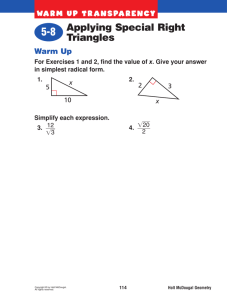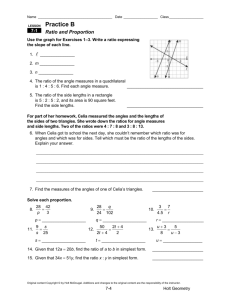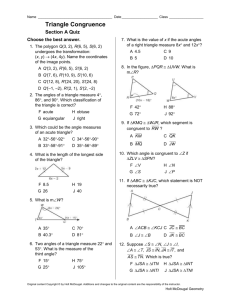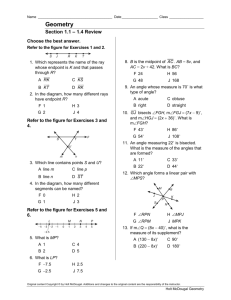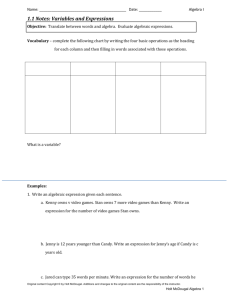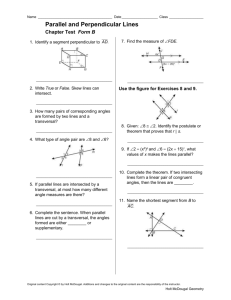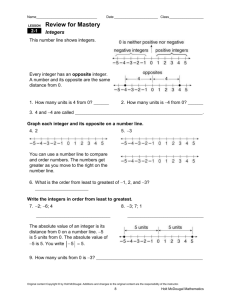Psychological Methods - Geary County Schools USD 475
advertisement
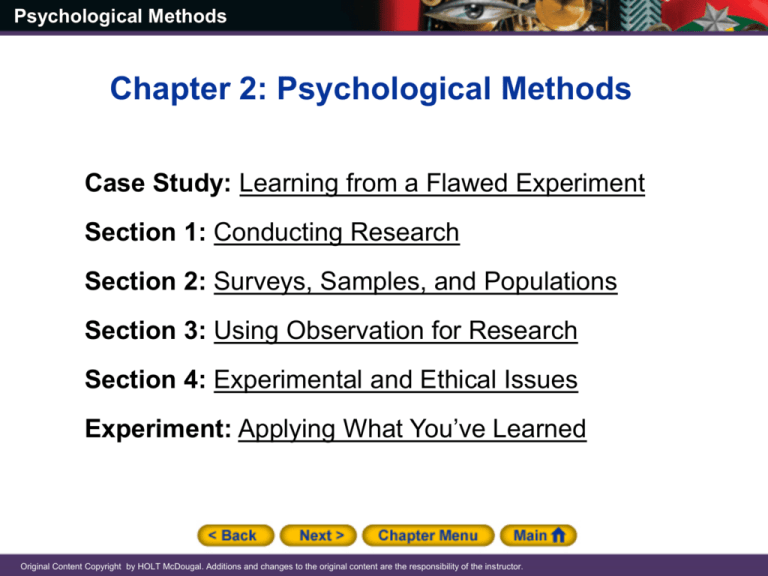
Psychological Methods Chapter 2: Psychological Methods Case Study: Learning from a Flawed Experiment Section 1: Conducting Research Section 2: Surveys, Samples, and Populations Section 3: Using Observation for Research Section 4: Experimental and Ethical Issues Experiment: Applying What You’ve Learned Original Content Copyright by HOLT McDougal. Additions and changes to the original content are the responsibility of the instructor. Psychological Methods Case Study: Learning from a Flawed Experiment The Hawthorne effect shows that research methods must be sound if the results of a study are to be reliable. The Hawthorne Effect • The Hawthorne effect is the tendency of research subjects to change their behavior as a result of their awareness of being observed. Flaws in the Hawthorne Study • Was not a blind study • Did not have a control group • Sample size was too small • Results of the study may have been misinterpreted • It was named for a 1927 workplace study. Original Content Copyright by HOLT McDougal. Additions and changes to the original content are the responsibility of the instructor. Psychological Methods What do you think? • What flaws did the Hawthorne study have, and how did these flaws affect the study’s outcome? • What is the Hawthorne effect, and why do some people question its existence? Original Content Copyright by HOLT McDougal. Additions and changes to the original content are the responsibility of the instructor. Psychological Methods Original Content Copyright by HOLT McDougal. Additions and changes to the original content are the responsibility of the instructor. Psychological Methods Section 1 at a Glance Conducting Research • Scientific research consists of five basic steps: forming a research question, forming a hypothesis, testing the hypothesis, analyzing the results, and drawing conclusions. • After the five steps are completed, scientists attempt to replicate the results and often ask new questions based on those results. Original Content Copyright by HOLT McDougal. Additions and changes to the original content are the responsibility of the instructor. Psychological Methods Conducting Research Main Idea The steps that scientists follow in conducting research are fundamental to reaching reliable conclusions. Psychologists follow similar steps in conducting research. Reading Focus • What are the five basic steps in scientific research? • What are two further steps involved in scientific research? Original Content Copyright by HOLT McDougal. Additions and changes to the original content are the responsibility of the instructor. Psychological Methods How can a scientific mistake lead to a scientific truth? Original Content Copyright by HOLT McDougal. Additions and changes to the original content are the responsibility of the instructor. Psychological Methods The Steps of Scientific Research Psychologists tend to use the same general procedure when conducting research. The procedure consists of six steps. Forming a Research Question Forming a Hypothesis • The first step is forming a research question. • Psychologists next form a hypothesis about the answer to the research question. • Research questions are best focused on behavior rather than constructs that cannot be seen or measured directly. • A hypothesis is an educated guess. • The accuracy of a hypothesis can be tested by research. Original Content Copyright by HOLT McDougal. Additions and changes to the original content are the responsibility of the instructor. Psychological Methods Testing the Hypothesis Analyzing the Results • The next step is testing the hypothesis. • Psychologists analyze the results after they have tested the hypothesis. • A hypothesis cannot be considered to be correct until it has been scientifically tested and proved to be right. • Opinions are not considered. • Psychologists rely on evidence. • Psychologists use a variety of research methods to test a hypothesis. • What do their findings mean? • The more information psychologists collect, the more complex a task it is to analyze it. • Psychologists often look for patterns and relationships in the data. Original Content Copyright by HOLT McDougal. Additions and changes to the original content are the responsibility of the instructor. Psychological Methods Drawing Conclusions • Psychologists draw conclusions about their research question and their hypothesis. • When observations do not support a hypothesis, they often must change the theories or beliefs from which the hypothesis was derived. • This means psychologists must keep open minds and adjust or modify their hypotheses if their findings make it necessary to do so. Original Content Copyright by HOLT McDougal. Additions and changes to the original content are the responsibility of the instructor. Psychological Methods Click on the image to play the Interactive. Original Content Copyright by HOLT McDougal. Additions and changes to the original content are the responsibility of the instructor. Psychological Methods Reading Check Find the Main Idea Where does a hypothesis occur in the steps of research? Answer: the second step; after a research question is formed Original Content Copyright by HOLT McDougal. Additions and changes to the original content are the responsibility of the instructor. Psychological Methods Further Steps in Scientific Research Replication New Questions • For the findings of a study to be confirmed, the study must be replicated, which means it must be repeated and produce the same results as before. • Research findings usually lead to new questions. • Some scientists repeat a study under different circumstances than in the original study. • Sometimes the study is repeated with a different set of participants. • New questions are tested using the same process. • Different research methods are used to test hypotheses. • These methods include the survey method, various observational methods, and the experimental method. • If the study involves people, participants can vary in gender, age, ethnicity, social and economic background, and location. Original Content Copyright by HOLT McDougal. Additions and changes to the original content are the responsibility of the instructor. Psychological Methods Reading Check Summarize Why must a study be replicated? Give three reasons. Answer: to see if it produces the same results under different circumstances, with different set of participants, or different types of participants Original Content Copyright by HOLT McDougal. Additions and changes to the original content are the responsibility of the instructor. Psychological Methods Section 2 at a Glance Surveys, Samples, and Populations • Scientists use the survey method by interviewing people or by distributing questionnaires. • Scientists must carefully choose which groups of people they wish to study. Original Content Copyright by HOLT McDougal. Additions and changes to the original content are the responsibility of the instructor. Psychological Methods Surveys, Samples, and Populations Main Idea One way to gather information is by asking people directly. Psychologists use this method to study people’s attitudes and behaviors. Reading Focus • What is the survey method? • How do populations and samples affect research? • How do psychologists select samples? • Why must researchers be careful in generalizing results? • What is volunteer bias? Original Content Copyright by HOLT McDougal. Additions and changes to the original content are the responsibility of the instructor. Psychological Methods What happened to your favorite show? Original Content Copyright by HOLT McDougal. Additions and changes to the original content are the responsibility of the instructor. Psychological Methods The Survey Method • Psychologists usually use a survey to gather information about people by asking them directly. • A survey is a series of questions people are asked to answer about a particular subject. • Psychologists conduct surveys by asking people to fill out written questionnaires or by interviewing people orally. • The findings of interviews and questionnaires may not be completely accurate. – People may not be honest about their attitudes or behavior. – People may limit their responses for privacy reasons. – People may say what they think the interviewers want to hear. Original Content Copyright by HOLT McDougal. Additions and changes to the original content are the responsibility of the instructor. Psychological Methods Reading Check Summarize How do psychologists conduct surveys? Answer: by asking people to fill out written questionnaires or by interviewing people orally Original Content Copyright by HOLT McDougal. Additions and changes to the original content are the responsibility of the instructor. Psychological Methods Populations and Samples • To accurately predict an outcome, psychologists study a group that represents the target population. • A target population is the whole group they want to study or describe. • The target population includes only people who are relevant to the survey. • Because it would be costly and difficult to interview or question every member of a target population, researchers study a sample. • A sample is only part of the target population. Original Content Copyright by HOLT McDougal. Additions and changes to the original content are the responsibility of the instructor. Psychological Methods Reading Check Summarize What is a target population? Answer: the whole group that a researcher wants to study or describe Original Content Copyright by HOLT McDougal. Additions and changes to the original content are the responsibility of the instructor. Psychological Methods Original Content Copyright by HOLT McDougal. Additions and changes to the original content are the responsibility of the instructor. Psychological Methods Selecting Samples • Psychologists select samples scientifically to ensure that the samples accurately represent the populations they are supposed to represent. • A sample should be as similar as possible to the target population. • One way that scientists obtain an accurate sample is to use a random sample, in which individuals are selected by chance from the target population. • Another type of sample is a stratified sample, which consists of subgroups in the population that are represented proportionally. • A large random sample is likely to be accurately stratified even if researchers take no steps to ensure that it is. • A large sample size by itself does not necessarily guarantee that a sample represents a target population. Original Content Copyright by HOLT McDougal. Additions and changes to the original content are the responsibility of the instructor. Psychological Methods Reading Check Summarize What is the difference between random and stratified samples? Answer: random—chosen by chance; stratified— subgroups of population represented proportionally Original Content Copyright by HOLT McDougal. Additions and changes to the original content are the responsibility of the instructor. Psychological Methods Generalizing Results • Sometimes researchers do not use a sample that represents an entire population. • In such cases, researchers are cautious about generalizing their findings. • Researchers cannot learn about the preferences of all people by studying only one group of people. • Researchers cannot learn about the attitudes of Americans in general if they limit their observations to only men or only women or to people who live in one part of the country or to people from one socioeconomic background. Original Content Copyright by HOLT McDougal. Additions and changes to the original content are the responsibility of the instructor. Psychological Methods Reading Check Draw Conclusions What are some limitations on generalizing results? Answer: A sample may not represent an entire population. Original Content Copyright by HOLT McDougal. Additions and changes to the original content are the responsibility of the instructor. Psychological Methods Volunteer Bias • When conducting surveys, psychologists are aware that bias may occur on the part of the respondents. • Bias is a predisposition to a certain point of view despite what the facts suggest. • Psychologists also are aware of volunteer bias. People who volunteer to participate in studies may have a different outlook from people who do not volunteer. – Volunteers are usually more willing to disclose personal information. – They may have more spare time to participate. – Volunteers probably do not represent the target population. Original Content Copyright by HOLT McDougal. Additions and changes to the original content are the responsibility of the instructor. Psychological Methods Reading Check Draw Conclusions What is the basic problem with volunteer bias in terms of research results? Answer: Volunteers may have a different outlook from people who do not volunteer for research studies. Original Content Copyright by HOLT McDougal. Additions and changes to the original content are the responsibility of the instructor. Psychological Methods Original Content Copyright by HOLT McDougal. Additions and changes to the original content are the responsibility of the instructor. Psychological Methods Cultural Diversity and Psychology Diversity in Research Most psychologists today appreciate the need to allow for the wider diversity of members of society in their research. This has not always been the case. For example, men have been included as research study participants more often than women. This led psychologists to mistakenly generalize their findings beyond men. • Many research participants were originally drawn from white men. • Studies that have included a more diverse population have shown that heart disease affects women differently than it affects men and that African Americans are more likely to get heart disease than whites. • More diversified research on domestic violence has revealed that men and children are victims as well as women . • Recent research with members of older populations has shed light on topics of concern to the elderly. Original Content Copyright by HOLT McDougal. Additions and changes to the original content are the responsibility of the instructor. Psychological Methods Original Content Copyright by HOLT McDougal. Additions and changes to the original content are the responsibility of the instructor. Psychological Methods Thinking Critically • What might be some ways to increase the number of participants from traditionally underrepresented groups in psychological studies? • How might you and your classmates respond to a question about the effect of after-school jobs on your education? How might students respond differently in a school with a different ethnic make-up? Original Content Copyright by HOLT McDougal. Additions and changes to the original content are the responsibility of the instructor. Psychological Methods Section 3 at a Glance Using Observation for Research • There are a number of other methods of observation besides the survey method: the testing method, the casestudy method, the longitudinal and cross-sectional methods, the naturalistic-observation method, and the laboratory-observation method. • Correlation describes relationships but does not reveal cause and effect. In analyzing the results of observations, correlation is an important technique. Original Content Copyright by HOLT McDougal. Additions and changes to the original content are the responsibility of the instructor. Psychological Methods Using Observation for Research Main Idea Psychologists use many different methods of observation in conducting their research. Then they use correlation to analyze and interpret their results. Reading Focus • What are some of the methods of observation in psychological research? • How do researchers analyze their observations? Original Content Copyright by HOLT McDougal. Additions and changes to the original content are the responsibility of the instructor. Psychological Methods Would you put a baby in a "baby box"? Original Content Copyright by HOLT McDougal. Additions and changes to the original content are the responsibility of the instructor. Psychological Methods Methods of Observation • In addition to the survey method of observation, other methods of observation include the testing, case-study, longitudinal, crosssectional, naturalistic-observation, and laboratory-observation methods. The Testing Method The Case-Study Method • Psychologists use several kinds of psychological tests, including: • A case study is an in-depth investigation of an individual or a small group. • Intelligence tests • Aptitude tests • Personality tests • Psychologists use what they learn in a case study to generalize broader principles that apply to the larger population. Original Content Copyright by HOLT McDougal. Additions and changes to the original content are the responsibility of the instructor. Psychological Methods The Longitudinal Method • In the longitudinal method, researchers select a group of participants and then observe those participants over a period of time, often years or even decades. • Psychologists use this method to observe how people change over time. The Cross-Sectional Method • In the cross-sectional method, instead of following a set of individuals over a number of years, researches select a sample that includes people of different ages. • This allows researchers to compare the behavior of participants in different age groups. Original Content Copyright by HOLT McDougal. Additions and changes to the original content are the responsibility of the instructor. Psychological Methods The Naturalistic-Observation Method • When psychologists observe children as they learn language naturally, such as while they interact with other children, they are using naturalistic observation. • In naturalistic observation, psychologists try not to interfere with the individuals they are observing. The Laboratory-Observation Method • When psychologists observe behavior in a laboratory rather than in the field, they are conducting laboratory observation. • A laboratory is any place that provides the opportunity for observation and experimentation. • The Skinner box and the maze are both examples of laboratories. Original Content Copyright by HOLT McDougal. Additions and changes to the original content are the responsibility of the instructor. Psychological Methods Reading Check Describe How does the cross-sectional method fix the longitudinal method? Answer: Cross-sectional methods are not as timeconsuming or as expensive as longitudinal methods. Original Content Copyright by HOLT McDougal. Additions and changes to the original content are the responsibility of the instructor. Psychological Methods Original Content Copyright by HOLT McDougal. Additions and changes to the original content are the responsibility of the instructor. Psychological Methods Original Content Copyright by HOLT McDougal. Additions and changes to the original content are the responsibility of the instructor. Psychological Methods Original Content Copyright by HOLT McDougal. Additions and changes to the original content are the responsibility of the instructor. Psychological Methods Analyzing the Observations One method psychologists use to analyze and interpret their observations is correlation. Correlation is a measure of how closely one thing is related to another. The stronger the correlation between two things, the more closely the two things are related. Positive and Negative Correlation • Positive correlation occurs when an increase in one thing is accompanied by an increase in the other. • Negative correlation occurs when a decrease in one thing is accompanied by a decrease in the other. Limits of Correlation • Correlation describes relationships, but it does not reveal cause and effect. • Just because two things are related does not necessarily mean that one causes the other. Original Content Copyright by HOLT McDougal. Additions and changes to the original content are the responsibility of the instructor. Psychological Methods Original Content Copyright by HOLT McDougal. Additions and changes to the original content are the responsibility of the instructor. Psychological Methods Reading Check Define What are some of the limits of correlation? Answer: does not reveal cause and effect Original Content Copyright by HOLT McDougal. Additions and changes to the original content are the responsibility of the instructor. Psychological Methods Current Research in Psychology Environmental Psychology Environmental psychology is a relatively new field that focuses on the interaction between people and their surroundings. It draws on anthropology, geography, urban design, and architecture. Researchers in this field observe people in real-life settings. By using this method, they can make recommendations about shaping the environment. • The environmental psychology movement can be traced to the work of Roger Barker, who developed the idea of “behavior setting.” • Environmental psychology has had a big impact on commercial venues where people spend money, such as stores, malls, stadiums, casinos, and airports. • The Graduate Center of the CUNY represents more recent developments in environmental psychology. • Most of the research done in environmental psychology takes place in the field rather than in the lab. Original Content Copyright by HOLT McDougal. Additions and changes to the original content are the responsibility of the instructor. Psychological Methods Original Content Copyright by HOLT McDougal. Additions and changes to the original content are the responsibility of the instructor. Psychological Methods Original Content Copyright by HOLT McDougal. Additions and changes to the original content are the responsibility of the instructor. Psychological Methods Thinking Critically • Who do you think would be likely to support research undertaken by environmental psychologists? • What are the circumstances in which shoppers are more likely to act as eager rather than skeptical or reluctant consumers? Original Content Copyright by HOLT McDougal. Additions and changes to the original content are the responsibility of the instructor. Psychological Methods Section 4 at a Glance Experimental and Ethical Issues • Researchers use experiments to answer questions about cause and effect. When conducting experiments, researchers must consider such things as independent and dependent variables, control groups, and the placebo effect. • Psychologists follow ethical practices and standards when working with people or animals. Original Content Copyright by HOLT McDougal. Additions and changes to the original content are the responsibility of the instructor. Psychological Methods Experimental and Ethical Issues Main Idea The experimental method is used by researchers to answer questions about cause and effect. In addition, psychologists must consider the ethical issues involved in their experiments. Reading Focus • How would you describe the primary purpose of the experimental method? • What is the purpose of single- and double-blind studies? • Why do researchers measure central tendency and dispersion? • What are three overriding ethical issues in psychology? • Why do scientists sometimes conduct research with animals? Original Content Copyright by HOLT McDougal. Additions and changes to the original content are the responsibility of the instructor. Psychological Methods Are the rights of animals considered in research experiments? Original Content Copyright by HOLT McDougal. Additions and changes to the original content are the responsibility of the instructor. Psychological Methods The Experimental Method • Psychologists use the experimental method to answer questions about cause and effect. • Independent and Dependent Variables – Experiments have variables, which are factors that can vary, or change. – The independent variable is the factor that researchers manipulate. – The dependent variable is the factor whose value depends on a change made to the independent variable. • Experimental and Control Groups – Members of an experimental group receive the treatment; members of a control group do not. – All other conditions are held constant for both the experimental group and the control group. – A controlled experiment uses both a control group and an experiment group. Original Content Copyright by HOLT McDougal. Additions and changes to the original content are the responsibility of the instructor. Psychological Methods • The Placebo Effect – A placebo is a substance or treatment that has no effect apart from a person’s belief in its effect. – Feeling better simply because we expect to feel better—and for no other reason—is an example of the placebo effect. Original Content Copyright by HOLT McDougal. Additions and changes to the original content are the responsibility of the instructor. Psychological Methods Reading Check Define In an experiment, what are variables? Answer: factors that can vary or change Original Content Copyright by HOLT McDougal. Additions and changes to the original content are the responsibility of the instructor. Psychological Methods Single- and Double-Blind Studies Single-Blind Studies • A single-blind study keeps participants unaware of the treatment they are receiving. • Participants do not know if they are in the experimental group or the control group. • This is one way that researchers can avoid the influence of expectations. Double-Blind Studies • A double-blind study is one in which both participants and researchers are unaware of who receives the treatment. • Double-blind studies help researchers avoid the influence of expectations and remain unbiased. Original Content Copyright by HOLT McDougal. Additions and changes to the original content are the responsibility of the instructor. Psychological Methods Original Content Copyright by HOLT McDougal. Additions and changes to the original content are the responsibility of the instructor. Psychological Methods Reading Check Compare What is the difference between a singleblind and double-blind study? Answer: single-blind—participants do not know if they are in experimental or control group; double-blind—neither the participants nor the experimenters know which participants are in the experimental and control groups Original Content Copyright by HOLT McDougal. Additions and changes to the original content are the responsibility of the instructor. Psychological Methods Central Tendency and Disposition • A common technique used to generalize data is to measure the central tendency. • The central tendency is a number that describes the average score of a distribution. • Finding the mean, median, or mode are ways of arriving at the central tendency. – The mean is the average score of a distribution. – The median is the middle score. – The mode is the most frequent score. • Researchers use range and standard deviation to document the variability of a score. – Range is the difference between the lowest score and the highest. – Standard deviation is a measure of distance of every score to the mean. Original Content Copyright by HOLT McDougal. Additions and changes to the original content are the responsibility of the instructor. Psychological Methods Reading Check Recall What is the relationship between standard deviation and the mean? Answer: The standard deviation is the measure of distance of every score to the mean; the mean is one way of measuring the average. Original Content Copyright by HOLT McDougal. Additions and changes to the original content are the responsibility of the instructor. Psychological Methods Original Content Copyright by HOLT McDougal. Additions and changes to the original content are the responsibility of the instructor. Psychological Methods Ethical Issues Ethics are standards for proper and responsible behavior. The American Psychological Association (APA) has established specific ethical guidelines that psychologists are required to follow. Research with People Confidentiality • Ethical standards limit the type of research psychologists may conduct with people. • Psychologists treat the records of research participants and clients as confidential. • A leading ethical principle is that study participants must not be harmed. • Only in certain cases may psychologists disregard confidentiality. Original Content Copyright by HOLT McDougal. Additions and changes to the original content are the responsibility of the instructor. Psychological Methods Informed Consent • The APA generally requires that people who volunteer to participate in research studies provide informed consent. • Informed consent means that people agree, or consent, to participate in a research study only after they receive a general overview of the study and have been given the choice of whether or not to participate. Deception • Some psychological experiments, however, cannot be run without deceiving people. • New drug experiments and other blind studies cannot be conducted without keeping participants unaware of the treatment or of the nature of the study. • Psychologists follow APA guidelines when they must use deception. Original Content Copyright by HOLT McDougal. Additions and changes to the original content are the responsibility of the instructor. Psychological Methods Original Content Copyright by HOLT McDougal. Additions and changes to the original content are the responsibility of the instructor. Psychological Methods Ethics in Using Data • Psychologists follow strict ethical rules in how they produce, store, and present their data. • They need to be objective as possible when conducting a study in order to avoid bias. • They must be willing to discuss their hypothesis in light of contradictory evidence collected in the research. Doing otherwise would be misleading and thus unethical. Original Content Copyright by HOLT McDougal. Additions and changes to the original content are the responsibility of the instructor. Psychological Methods Reading Check Define Why is confidentiality so important in psychology? Answer: respect individual’s privacy; help ensure true information, honest answers Original Content Copyright by HOLT McDougal. Additions and changes to the original content are the responsibility of the instructor. Psychological Methods Original Content Copyright by HOLT McDougal. Additions and changes to the original content are the responsibility of the instructor. Psychological Methods Research With Animals • Most psychological studies that use animals do not harm the animals. • Sometimes psychologists and other scientists conduct research that may be harmful to animals. • Such studies often use animals because they cannot be carried out with people for ethical reasons. • Psychologists use animals only when there is no alternative and when they believe the benefit outweighs the harm. • Only a small number of psychological studies involve animals. • Many people, however, believe that it is no more ethical to harm animals than it is to harm people. • The APA has rules of ethics for how animals used in research should be treated. Original Content Copyright by HOLT McDougal. Additions and changes to the original content are the responsibility of the instructor. Psychological Methods Reading Check Recall Why are rules needed for the treatment of animals in experiments? Answer: to ensure ethical treatments Original Content Copyright by HOLT McDougal. Additions and changes to the original content are the responsibility of the instructor. Psychological Methods Experiment: Applying What You’ve Learned The Hypothetical Snack Bar Among students at our school, are stated preferences for cola soft drinks and tortilla chips consistent with preferences when these items are taste-tested? 1. Introduction 2. Conducting the Cola Experiment • The premise of the experiment is to conduct a double-blind taste test study. • Use a shield between the subject and the tester. • Begin by recording favorite soda flavors and favorite tortilla chip flavors. • Have the subject test three cups of soda poured by assistants who know which soda is in which cup. • Use a blindfold for the subject. Original Content Copyright by HOLT McDougal. Additions and changes to the original content are the responsibility of the instructor. Psychological Methods Experiment (con’t.) 3. Conducting the Tortilla Chip Experiment • Use a shield between the subject and the tester. • Use a blindfold for the subject. • Follow the same steps with the tortilla chips as with the cola drinks. • Use the same brand of chips but three different flavors. 4. Discussion • Was the hypothesis proved or disproved? • Which subject matter that you studied in this chapter was touched on by these experiments? • What did you learn from this experiment? • The subject tests three servings of chips by assistants who have recorded which chips are in which bowl. Original Content Copyright by HOLT McDougal. Additions and changes to the original content are the responsibility of the instructor. Psychological Methods Original Content Copyright by HOLT McDougal. Additions and changes to the original content are the responsibility of the instructor. Psychological Methods Original Content Copyright by HOLT McDougal. Additions and changes to the original content are the responsibility of the instructor.

